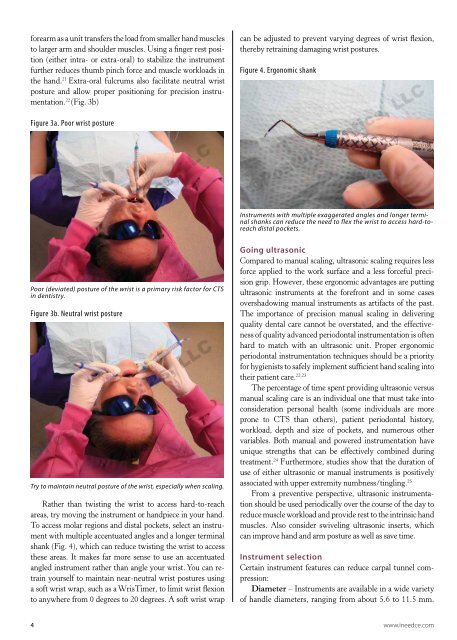Getting the Upper Hand on Pain: Preventing Hand ... - IneedCE.com
Getting the Upper Hand on Pain: Preventing Hand ... - IneedCE.com
Getting the Upper Hand on Pain: Preventing Hand ... - IneedCE.com
Create successful ePaper yourself
Turn your PDF publications into a flip-book with our unique Google optimized e-Paper software.
forearm as a unit transfers <str<strong>on</strong>g>the</str<strong>on</strong>g> load from smaller hand muscles<br />
to larger arm and shoulder muscles. Using a finger rest positi<strong>on</strong><br />
(ei<str<strong>on</strong>g>the</str<strong>on</strong>g>r intra- or extra-oral) to stabilize <str<strong>on</strong>g>the</str<strong>on</strong>g> instrument<br />
fur<str<strong>on</strong>g>the</str<strong>on</strong>g>r reduces thumb pinch force and muscle workloads in<br />
<str<strong>on</strong>g>the</str<strong>on</strong>g> hand. 21 Extra-oral fulcrums also facilitate neutral wrist<br />
posture and allow proper positi<strong>on</strong>ing for precisi<strong>on</strong> instrumentati<strong>on</strong>.<br />
22 (Fig. 3b)<br />
Figure 3a. Poor wrist posture<br />
Poor (deviated) posture of <str<strong>on</strong>g>the</str<strong>on</strong>g> wrist is a primary risk factor for CTS<br />
in dentistry.<br />
Figure 3b. Neutral wrist posture<br />
Try to maintain neutral posture of <str<strong>on</strong>g>the</str<strong>on</strong>g> wrist, especially when scaling.<br />
Ra<str<strong>on</strong>g>the</str<strong>on</strong>g>r than twisting <str<strong>on</strong>g>the</str<strong>on</strong>g> wrist to access hard-to-reach<br />
areas, try moving <str<strong>on</strong>g>the</str<strong>on</strong>g> instrument or handpiece in your hand.<br />
To access molar regi<strong>on</strong>s and distal pockets, select an instrument<br />
with multiple accentuated angles and a l<strong>on</strong>ger terminal<br />
shank (Fig. 4), which can reduce twisting <str<strong>on</strong>g>the</str<strong>on</strong>g> wrist to access<br />
<str<strong>on</strong>g>the</str<strong>on</strong>g>se areas. It makes far more sense to use an accentuated<br />
angled instrument ra<str<strong>on</strong>g>the</str<strong>on</strong>g>r than angle your wrist. You can retrain<br />
yourself to maintain near-neutral wrist postures using<br />
a soft wrist wrap, such as a WrisTimer, to limit wrist flexi<strong>on</strong><br />
to anywhere from 0 degrees to 20 degrees. A soft wrist wrap<br />
can be adjusted to prevent varying degrees of wrist flexi<strong>on</strong>,<br />
<str<strong>on</strong>g>the</str<strong>on</strong>g>reby retraining damaging wrist postures.<br />
Figure 4. Erg<strong>on</strong>omic shank<br />
Instruments with multiple exaggerated angles and l<strong>on</strong>ger terminal<br />
shanks can reduce <str<strong>on</strong>g>the</str<strong>on</strong>g> need to flex <str<strong>on</strong>g>the</str<strong>on</strong>g> wrist to access hard-toreach<br />
distal pockets.<br />
Going ultras<strong>on</strong>ic<br />
Compared to manual scaling, ultras<strong>on</strong>ic scaling requires less<br />
force applied to <str<strong>on</strong>g>the</str<strong>on</strong>g> work surface and a less forceful precisi<strong>on</strong><br />
grip. However, <str<strong>on</strong>g>the</str<strong>on</strong>g>se erg<strong>on</strong>omic advantages are putting<br />
ultras<strong>on</strong>ic instruments at <str<strong>on</strong>g>the</str<strong>on</strong>g> forefr<strong>on</strong>t and in some cases<br />
overshadowing manual instruments as artifacts of <str<strong>on</strong>g>the</str<strong>on</strong>g> past.<br />
The importance of precisi<strong>on</strong> manual scaling in delivering<br />
quality dental care cannot be overstated, and <str<strong>on</strong>g>the</str<strong>on</strong>g> effectiveness<br />
of quality advanced period<strong>on</strong>tal instrumentati<strong>on</strong> is often<br />
hard to match with an ultras<strong>on</strong>ic unit. Proper erg<strong>on</strong>omic<br />
period<strong>on</strong>tal instrumentati<strong>on</strong> techniques should be a priority<br />
for hygienists to safely implement sufficient hand scaling into<br />
<str<strong>on</strong>g>the</str<strong>on</strong>g>ir patient care. 22,23<br />
The percentage of time spent providing ultras<strong>on</strong>ic versus<br />
manual scaling care is an individual <strong>on</strong>e that must take into<br />
c<strong>on</strong>siderati<strong>on</strong> pers<strong>on</strong>al health (some individuals are more<br />
pr<strong>on</strong>e to CTS than o<str<strong>on</strong>g>the</str<strong>on</strong>g>rs), patient period<strong>on</strong>tal history,<br />
workload, depth and size of pockets, and numerous o<str<strong>on</strong>g>the</str<strong>on</strong>g>r<br />
variables. Both manual and powered instrumentati<strong>on</strong> have<br />
unique strengths that can be effectively <strong>com</strong>bined during<br />
treatment. 24 Fur<str<strong>on</strong>g>the</str<strong>on</strong>g>rmore, studies show that <str<strong>on</strong>g>the</str<strong>on</strong>g> durati<strong>on</strong> of<br />
use of ei<str<strong>on</strong>g>the</str<strong>on</strong>g>r ultras<strong>on</strong>ic or manual instruments is positively<br />
associated with upper extremity numbness/tingling. 25<br />
From a preventive perspective, ultras<strong>on</strong>ic instrumentati<strong>on</strong><br />
should be used periodically over <str<strong>on</strong>g>the</str<strong>on</strong>g> course of <str<strong>on</strong>g>the</str<strong>on</strong>g> day to<br />
reduce muscle workload and provide rest to <str<strong>on</strong>g>the</str<strong>on</strong>g> intrinsic hand<br />
muscles. Also c<strong>on</strong>sider swiveling ultras<strong>on</strong>ic inserts, which<br />
can improve hand and arm posture as well as save time.<br />
Instrument selecti<strong>on</strong><br />
Certain instrument features can reduce carpal tunnel <strong>com</strong>pressi<strong>on</strong>:<br />
Diameter – Instruments are available in a wide variety<br />
of handle diameters, ranging from about 5.6 to 11.5 mm.<br />
4 www.ineedce.<strong>com</strong>

















